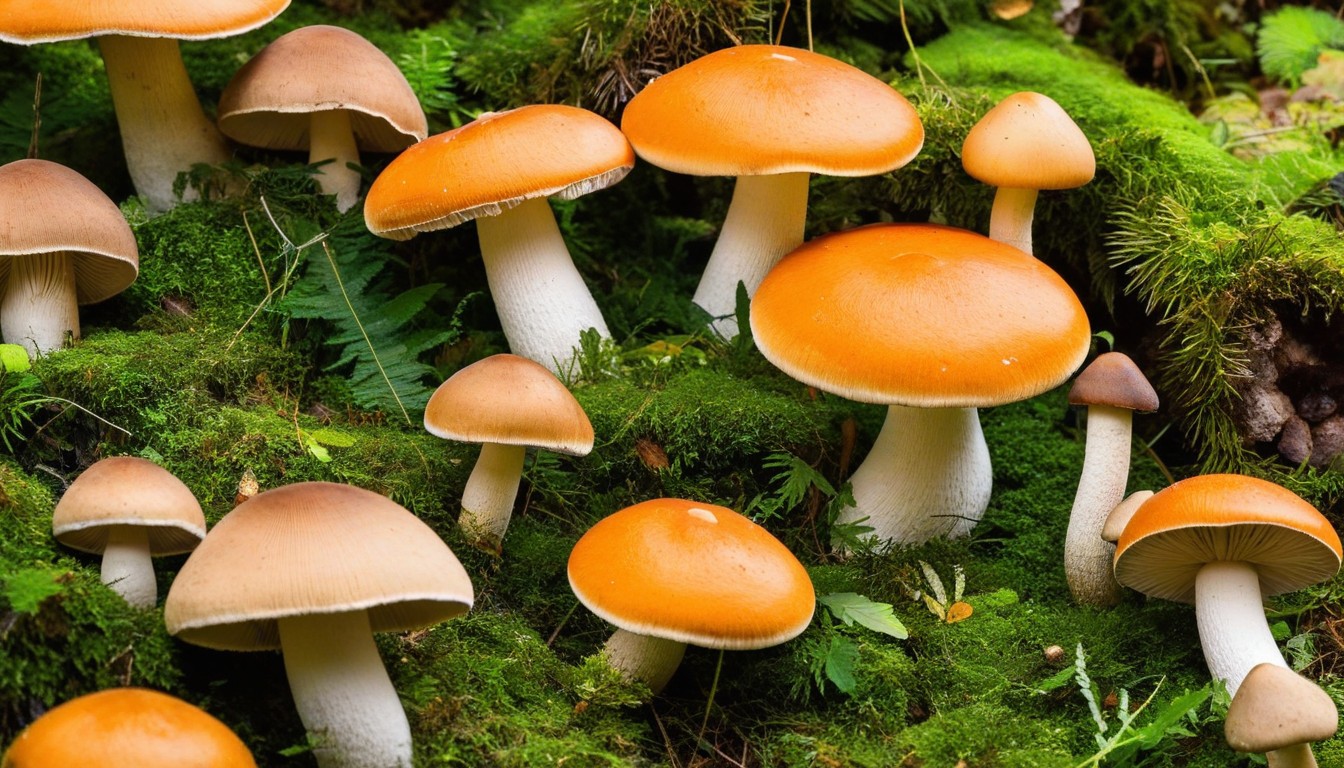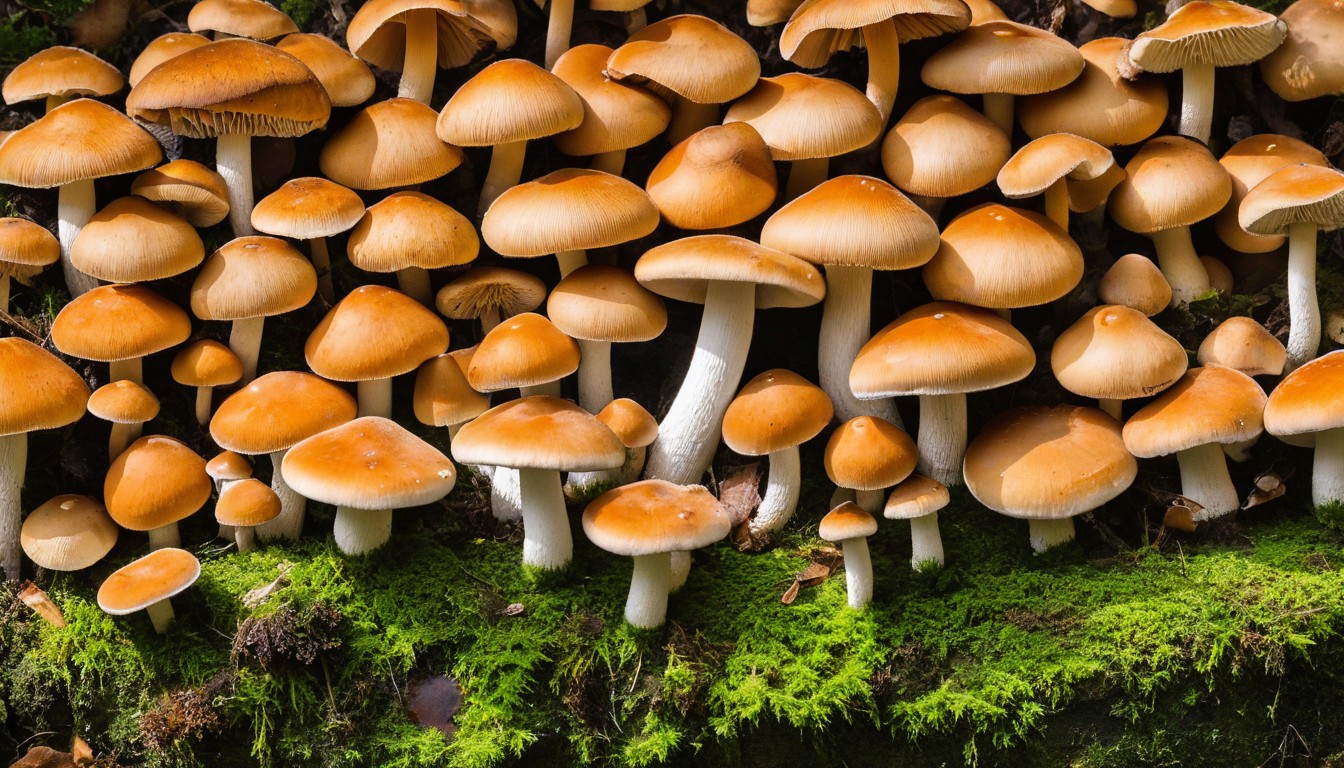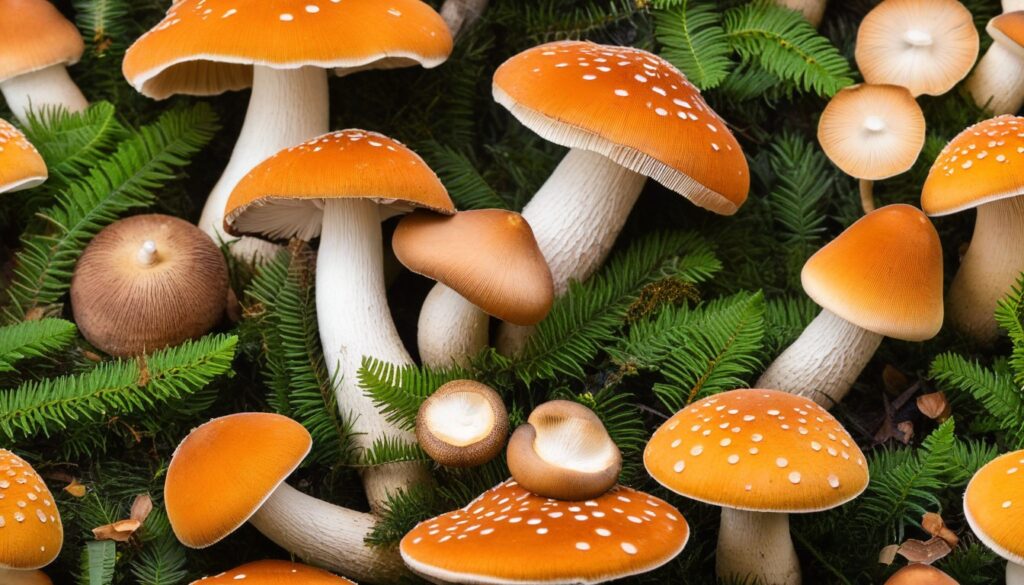Are you looking for a new and exciting outdoor activity in North Georgia? Why not try mushroom foraging? Not only is it a fun and adventurous way to explore the region’s stunning scenery, but it’s also an opportunity to discover a diverse array of edible mushrooms.
This comprehensive foraging guide will equip you with all the know-how needed to embark on a safe and enjoyable mushroom hunting adventure in North Georgia. From identifying edible mushrooms to locating the best foraging spots, we’ve got you covered.
Key Takeaways:
- Explore the diverse world of edible mushrooms in North Georgia through proper identification techniques.
- Understand the importance of practicing responsible mushroom foraging etiquette to protect local ecosystems.
- Discover common edible mushroom species found in North Georgia, and their distinguishing features and habitats.
- Learn tips and strategies to ensure safe mushroom identification and increase your foraging success rate.
- Uncover culinary and medicinal uses of edible mushrooms in North Georgia.
The Importance of Mushroom Foraging Etiquette
Mushroom foraging can be a rewarding experience, but it’s crucial to follow proper etiquette to ensure the preservation of the local ecosystems. Responsible foraging practices not only protect the environment but also help promote sustainable harvesting for future generations.
One essential aspect of mushroom foraging etiquette is to respect the natural environment. Avoid collecting mushrooms in environmentally sensitive areas, such as near streams or in protected habitats. Be mindful of other plant species and animals in the area and avoid disturbing their habitats.
It’s also vital to understand the appropriate regulations and restrictions for mushroom foraging in the region. In North Georgia, for example, foraging is not permitted in state parks or other protected areas. Be sure to check with local agencies for current regulations and restrictions before beginning your foraging journey.
Another critical component of responsible foraging is practicing proper identification techniques. Mistakenly identifying or collecting poisonous mushrooms can have dangerous consequences. Take the time to learn about the distinct characteristics of edible mushrooms and non-edible or poisonous species.
By following these essential mushroom foraging etiquette practices, you can ensure the preservation of the local environment and promote a sustainable foraging culture. Happy foraging!
Common Edible Mushroom Species in North Georgia
North Georgia offers a variety of delicious and nutritious edible mushrooms for foragers to discover. Here are some of the most common edible mushroom species found in the region:
|
Species |
Distinguishing Features |
Habitat |
Best Time to Forage |
|---|---|---|---|
|
Honey Mushroom |
Fleshy cap with a sticky, yellow-brown cap surface; white gills; thick stem with a white annulus. |
Grows on dead or dying trees, particularly oaks and maples. |
Mid-summer to early autumn. |
|
Chanterelle |
Trumpet-shaped cap; wavy edges; vibrant yellow-orange color; ridges instead of gills. |
Grows on the forest floor, particularly under hardwood trees. |
Mid-summer to late autumn. |
|
Black Trumpet |
Trumpet-shaped cap; black, gray, or brown color; wavy and irregular cap edges. |
Grows on the forest floor, particularly under hardwood trees. |
Late summer to early winter. |
|
Morel |
Hollow, sponge-like cap; conical or oblong shape with a honeycomb-like surface; beige to brown color. |
Grows in forests, particularly near dead or dying trees. |
Early to mid-spring. |
|
Lion’s Mane |
Globe-shaped and shaggy, resembling a lion’s mane; white to cream color. |
Grows on dead or dying hardwood trees, particularly oak and maple. |
Throughout the year, with a peak in autumn. |
Remember to only forage for mushrooms that you are certain are edible and to practice responsible foraging techniques to preserve North Georgia’s ecosystems.
Ensuring Safe Mushroom Identification

Proper identification techniques are crucial when foraging for mushrooms in North Georgia. To ensure safe and successful experiences, it is essential to learn and follow key characteristics of different species. Enrich your knowledge with these tips:
Key Characteristics to Look For
|
Mushroom Part |
Characteristic |
|---|---|
|
Cap |
Color, shape, size, texture, and whether it is conical, parabolic, or plane |
|
Gills (Lamellae) |
Color, attachment to the cap, and distance between them |
|
Ring (Annulus) |
Whether it is present or not, and if so, its size, shape, and position |
|
Stem |
Color, shape, texture, and any characteristic features. Also, check whether it has a bulbous base. |
|
Skin (Flesh) |
Color, thickness, aroma, and whether it bruises or changes color when touched. |
Learning about mushroom anatomy and the features of different species can help you identify one species from another.
Useful Identification Resources
Foraging guides, books, smartphone apps, and online resources are valuable tools for identification. Buy, borrow, or download them to improve your skills and knowledge. But remember, no app, book, or resource can replace the expertise of a trained mycologist. Use them only as a supplementary aid.
Important Safety Considerations Specific to North Georgia Mushrooms

- Some mushrooms in North Georgia contain toxic substances that can cause severe reactions. Avoid consuming mushrooms that you cannot identify.
- Although some edible mushrooms resemble poisonous species, the reverse is not valid. Never assume that a mushroom is edible unless you are 100% confident you’ve identified it correctly.
- Symptoms from ingesting toxic mushrooms can occur within hours or days. Seek medical attention immediately if you experience any adverse signs or symptoms after consuming mushrooms.
By following these key tips and considerations, you can increase your chances of identifying edible mushrooms while avoiding more questionable specimens found in North Georgia.
Favorite Foraging Spots in North Georgia
North Georgia is a haven for mushroom hunters, with plenty of foraging spots to explore. Below are some of the favorite areas among foragers:
|
Foraging Spot |
Location |
Best Time to forage |
|---|---|---|
|
Unicoi State Park |
Helen, GA |
September – October |
|
Chattahoochee National Forest |
Blairsville, GA |
October – November |
|
Fort Mountain State Park |
Chatsworth, GA |
September – October |
|
Smithgall Woods State Park |
Helen, GA |
September – October |
Aside from the ones listed above, other popular spots include Raven Cliff Falls Trail, Coopers Creek Wildlife Management Area, and Black Rock Mountain State Park. However, it’s best to check with local authorities for rules and regulations on collection before setting out for these foraging spots.
Don’t forget to bring your mushroom identification guide and tools to safely collect and properly identify your finds.
Tips for Successful Mushroom Foraging

Foraging for mushrooms in North Georgia can be an exhilarating experience, but it’s not always easy to find them. Utilize these tips to increase your chances of success:
- Understand your environment: Different mushroom species grow in different environments. Learn about the types of mushrooms you’re looking for and where they thrive. For example, morels prefer wooded areas with moist soil.
- Check the weather: Keep an eye on the weather forecast before you head out. Many mushroom species grow during specific times of the year or after certain weather events, such as rain. Knowing this information can help you pinpoint the best time and place to forage.
- Bring a field guide: A good field guide is essential for proper mushroom identification. Make sure to bring one with you and refer to it often. Practice identifying mushrooms before you go out, so you’re better equipped to recognize them in the wild.
- Be patient: Foraging for mushrooms requires patience and attention to detail. Take your time and examine every potential hiding spot. It’s better to move slowly and find a few quality specimens than rush and miss out on finding prime picks.
- Join a community: Joining a local mushroom foraging community can be a great way to gain knowledge and insights on what to look for, where to look, and when to look. Interacting with experienced foragers can dramatically increase your chances of success and make mushroom foraging a more enjoyable experience.
Culinary Delights: Cooking with Edible Mushrooms
Now that you have successfully foraged for North Georgia’s edible mushrooms, it’s time to unleash their culinary potential. These versatile fungi can add depth and flavor to a variety of dishes, from soups and risottos to pizzas and salads.
Cooking Techniques
The key to cooking with mushrooms is to showcase their unique texture and flavor. Sautéing, grilling, and roasting are some of the most popular cooking techniques that bring out the natural umami taste of mushrooms.
Popular Dishes
Some of the most popular dishes that feature North Georgia’s edible mushrooms are:
|
Dish |
Description |
|---|---|
|
Mushroom Risotto |
A creamy, rice-based dish that highlights the earthy taste of mushrooms. |
|
Mushroom Burger |
A vegetarian burger patty made with finely minced mushrooms, served with toppings like cheese, lettuce, and tomato. |
|
Mushroom Soup |
A comforting bowl of soup made with mushrooms and savory broth, garnished with fresh herbs. |
|
Mushroom Pizza |
A crispy pizza crust topped with sautéed mushrooms, mozzarella cheese, and your favorite toppings. |
Recipe Ideas
If you’re looking to experiment with new recipes featuring North Georgia’s edible mushrooms, consider trying some of these ideas:
- Stir-fry mushrooms with garlic, soy sauce, and sesame oil for a quick and easy side dish.
- Make a hearty mushroom stew with vegetables, herbs, and beef broth.
- Add chopped mushrooms to quiches or frittatas for a protein-rich breakfast or brunch option.
- Stuff large mushroom caps with cheese, breadcrumbs, and herbs, then bake for a tasty appetizer or snack.
With so many culinary uses for North Georgia’s edible mushrooms, you’ll never run out of inspiration for creative and delicious meals.
Medicinal Properties of Edible Mushrooms in North Georgia

Besides being delicious, edible mushrooms found in North Georgia come with many health benefits. These mushrooms are packed with immune-boosting factors, anti-inflammatory properties, and numerous other medicinal benefits. Some varieties can even contribute to overall well-being and mental health.
The following table summarizes some of the common North Georgia edible mushrooms, their medicinal properties, and the primary health benefits they offer:
|
Mushroom Name |
Medicinal Properties |
Health Benefits |
|---|---|---|
|
Reishi |
Adaptogenic, immunomodulatory, anti-inflammatory |
Improves immune function, reduces inflammation, decreases stress |
|
Maitake |
Antioxidant, immune enhancer, anti-inflammatory |
Reduces inflammation, fights cancer cells, lowers blood sugar |
|
Shiitake |
Cholesterol-lowering, anti-viral, anti-cancer |
Lowers cholesterol, supports immune system, fights cancer cells |
|
Lion’s Mane |
Neuroprotective, anti-inflammatory, immune booster |
Improves cognitive function, reduces inflammation, boosts immune system |
It’s important to note that while these mushrooms offer many health benefits, they should never be used in place of medical treatment. It’s always essential to consult with a healthcare provider before incorporating any new additions to your diet.
With their numerous medicinal properties and benefits, it’s no wonder edible mushrooms in North Georgia are a popular choice for both culinary and healthcare enthusiasts.
Environmental Impact of Mushroom Foraging
For many foragers, the thrill of discovering edible mushrooms is unmatched. However, it’s crucial to understand that foraging can have a significant environmental impact if not carried out responsibly. For instance, overharvesting can lead to the depletion of mushroom populations, altering the ecosystems’ balance. Additionally, disturbing the soil and surrounding vegetation during foraging activities can damage natural habitats and ultimately impact wildlife populations.
It’s therefore essential to cultivate sustainable foraging practices that prioritize preserving the environment and its delicate mechanisms. This involves foraging in moderation, ensuring that ecosystems have sufficient time to regenerate. Harvesting selectively, optimizing the gathering of mature fruiting bodies, and avoiding the collection of mushrooms that have yet to reach full maturity can aid in maintaining healthy populations.
Another critical factor to consider is foraging in designated areas. Some regions, such as national parks, require permits for mushroom hunting. Moreover, foraging in protected areas is forbidden in many regions to prevent ecological harm. By researching local regulations and foraging responsibly, we can help ensure the preservation of North Georgia’s delicate ecosystems.
Practicing Sustainable Mushroom Foraging
Here are some tips to promote sustainable mushroom foraging:
- Forage in moderation, avoiding over-harvesting of mushroom populations
- Harvest selectively by gathering mature fruiting bodies and avoiding younger ones
- Forage in designated areas and avoid protected areas
- Practice Leave No Trace principles and avoid damaging surrounding vegetation and habitats
- Consider joining a local foraging group where you can learn from experienced foragers and practice responsible foraging techniques
By foraging sustainably and responsibly, we can continue to enjoy the pleasures of North Georgia’s edible mushrooms while also preserving the environment’s health and well-being.
Mushroom Foraging Safety Precautions
Foraging for edible mushrooms in North Georgia can be a thrilling experience. However, it’s crucial to prioritize your safety while embarking on such adventures. Here are some precautions to follow:
Understand Poisonous Species
Knowing how to identify poisonous mushroom species is critical for your safety while foraging. Research and learn about toxic mushroom species in North Georgia, such as the Death Cap mushroom. It’s best to refrain from picking any mushrooms until you are confident that you can correctly identify them.
Carry Essential Safety Equipment
Always carry essential safety equipment with you while foraging. Some necessary items include a first aid kit, a compass, sunscreen, insect repellent, and appropriate footwear. Also, pack containers that separate edible from non-edible mushrooms.
Protect Yourself from Hazards
While foraging, be cautious of hazards such as poison ivy, snakes, and other wildlife in the area. Wear protective clothing, preferably long pants and sleeves, and utilize mosquito and bug repellent spray.
Expert Tip: Always let someone know where you are going and when you plan to return. It’s also useful to carry a phone or other device that can call for help in case of an emergency.
In conclusion, prioritize your safety while foraging for mushrooms in North Georgia. Educate yourself on poisonous species, carry essential safety equipment and protect yourself from hazards. By doing so, you can enjoy your mushroom foraging adventures with peace of mind.
Join the Thriving North Georgia Mushroom Foraging Community
Foraging for mushrooms is an exciting and rewarding experience, and joining a community of like-minded individuals can enhance the experience even further. North Georgia is home to a vibrant and welcoming mushroom foraging community that offers a wealth of resources for enthusiasts of all levels.
Local groups such as the North American Mycological Association (NAMA) or the Georgia Mushroom Hunters (GMH) offer opportunities to connect with other foragers, share knowledge, and participate in events. You can also join online forums and social media groups to expand your network and stay up-to-date on the latest foraging tips and information.
Enthusiast groups often organize group forays, where experienced foragers lead expeditions to the best mushroom hunting spots in North Georgia. These excursions provide a unique opportunity to learn from experts, discover new species, and socialize with other foragers.
By joining the North Georgia mushroom foraging community, you can enhance your knowledge, form new friendships, and foster a sense of shared passion for edible mushrooms.
Conclusion
Congratulations! You are now equipped with the necessary knowledge and resources to embark on exciting mushroom hunting adventures in North Georgia. Remember to practice responsible foraging by respecting the environment and following proper mushroom foraging etiquette.
Proper identification of edible mushrooms is crucial, ensuring that you can distinguish them from harmful species. Use the resources provided in this guide and take extra precautions to ensure your safety while foraging.
Once you have successfully foraged for edible mushrooms, explore their culinary potential through delightful recipes and dishes that showcase the unique flavors and textures of North Georgia’s edible mushroom species.
Moreover, beyond their culinary applications, many edible mushrooms in North Georgia possess notable medicinal properties that could contribute to your overall well-being. By practicing sustainable foraging methods, you can preserve the delicate balance of North Georgia’s ecosystems and continue enjoying the diverse and delicious world of edible mushrooms.
Finally, we encourage you to join the vibrant North Georgia mushroom foraging community and connect with like-minded enthusiasts. By sharing knowledge, support, and a passion for edible mushrooms, we can continue to learn, grow, and explore the outdoors together.
Thank you for reading this guide, and we wish you the best of luck in your future mushroom hunting adventures!
FAQ
What are edible mushrooms?
Edible mushrooms are fungi that are safe for consumption and can be used in various culinary preparations. They offer unique flavors and textures.
Are all wild mushrooms in North Georgia edible?
No, not all wild mushrooms in North Georgia are edible. Some species can be toxic or even deadly if ingested. It is crucial to properly identify mushrooms before consuming them.
How do I know if a mushroom is edible?
Proper mushroom identification is essential to determine whether a mushroom is safe to eat or not. Characteristics such as cap shape, gills or pores, spore color, and habitat can help in identification.
Where can I find edible mushrooms in North Georgia?
Edible mushrooms can be found in various habitats in North Georgia, including forests, wooded areas, and sometimes even in urban settings. Look for them near trees, logs, and decaying organic matter.
Are there any poisonous mushrooms in North Georgia?
Yes, there are several poisonous mushrooms in North Georgia. It is important to be able to distinguish between edible and toxic species to avoid any health risks.
What precautions should I take while mushroom foraging?
When mushroom foraging, it is crucial to carry essential safety equipment, such as a field guide, knife, gloves, and a basket. Also, make sure to stay on designated trails and avoid trespassing on private property.
How can I join the North Georgia mushroom foraging community?
To join the North Georgia mushroom foraging community, you can explore local enthusiast groups, attend workshops or foraging events, and participate in online forums dedicated to mushroom identification and hunting.

